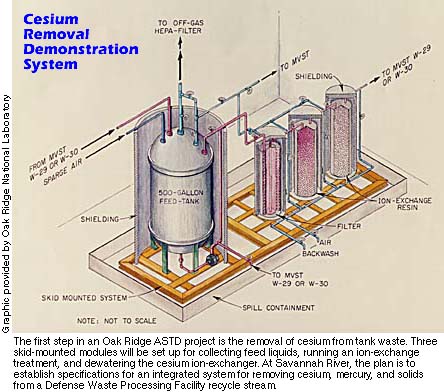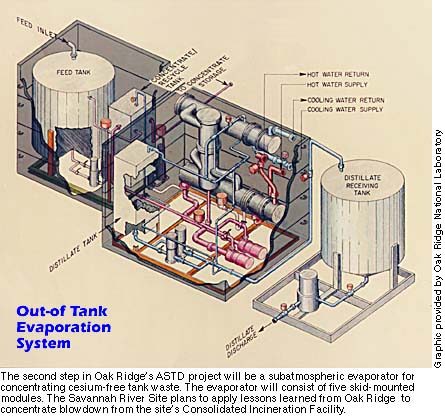 DOE's Office
of Science and Technology
is funding the Accelerated Site Technology Deployment
(ASTD) program, formerly known as the Technology
Deployment Initiative (see back issues of Initiatives).
Projects in the program promise to reduce the cost of
environmental management and accelerate cleanup
throughout the complex.
Linking
two systems to consolidate tank waste
One of the ASTD projects for FY 1998
is the implementation of an integrated cesium removal and
evaporator system to concentrate tank waste at Oak Ridge National Laboratory
(ORNL). During other deployments planned for the Savannah River Site, the
cesium removal and evaporator systems will separately
attack different problems.
By joining the cesium removal unit with the
subatmospheric evaporator, the ASTD project will
efficiently reduce the radioactivity and volume of tank
waste. This project contributes to ORNL's effort to
consolidate its tank waste into a few designated tanks in
preparation for the site choosing private-sector
contractors to treat and dispose of ORNL's tank waste.
Both systems have already been successfully demonstrated
separately. A full-scale demonstration of the cesium
removal technology was funded jointly by DOE's offices of
Science and Technology (OST, EM-50) and Waste
Management (EM-30)
and conducted at ORNL in September 1997. This system is
composed of three compact, skid-mounted modules—one
for collecting feed liquids, one for an ion-exchange
treatment, and one for dewatering the cesium
ion-exchanger. Each module has secondary containment and
modular radiation shielding. A key component of this unit
is the effectiveness of the ion-exchange material,
crystalline silicotitanate (CST), an inorganic
ion-exchange material that was developed in laboratory
tests through the combined efforts of Sandia National
Laboratories, UOP Molecular Sieves, and Texas A&M
University. During its demonstration, the unit removed
1,000 curies of cesium from 30,000 gallons of surrogate
waste using 70 gallons of CST.

A full-scale demonstration of the subatmospheric
evaporator was also funded jointly by OST and EM-30 at
ORNL in April 1996. This system is composed of five
compact, skid-mounted modules—each having secondary
containment and modular radiation shielding. The
evaporator successfully reduced the volume by 25 percent
of 22,000 gallons of Oak Ridge high-activity tank waste.
CST-the
cutting edge of cesium removal
CST inorganic resins are intended
for one-time use, thus eliminating the secondary waste
generated during reprocessing of organic ion exchangers
and permitting the design and operation of a much simpler
facility. The standard ion-exchange material is organic
resins that remove not only cesium, but similar chemicals
such as calcium and magnesium. Sharon Robinson, technical
lead for the project at ORNL, notes that "CST is
designed specifically to remove cesium; it's highly
selective for cesium. This project will be DOE's first
deployment of CST."
When CST snares hazardous components in addition to
cesium or other radioactive material, it must be treated
as a mixed waste. One way to do this is to vitrify, or
make glass out of, the CST. The Savannah River Technology
Center has determined that CST can be effectively
vitrified if necessary to comply with mixed waste
requirements. Robinson notes that when the cesium removal
unit is used at Savannah River or Hanford, heavy metals
are expected to be in the waste stream. Vitrification at
these sites will be a viable way to encapsulate and
solidify CST. However, the CST used for the ORNL project
isn't expected to contain hazardous materials in addition
to cesium, so vitrification won't be required. ORNL plans
to dispose of its cesium-loaded CST at the Nevada Test
Site.
From
orange juice condenser to tank waste evaporator
Robinson describes the procurement
of the evaporator as "an off-the-shelf
technology" but OST had to adapt the technology for
use in a radioactive environment. Robinson says the
evaporator has been used in the food industry for
condensing orange juice. "You're taking something
from an environment like that to something that is
radioactive where you have to do totally remote
operations, and you're dealing with an entirely different
stream going through the evaporator."

Benefits
of a cesium removal and evaporator merger
The integrated system's first step
is removal of cesium from the tank waste stream, followed
by the evaporator's role of concentrating the resulting
cesium-free waste. Sole reliance on the evaporator would
concentrate cesium in the distillate of the evaporator,
creating a more complicated and less efficient process.
ORNL procured both systems as modular units. Robinson
says "You bring them in, hook them up, put temporary
shielding around them, operate them and then move them to
another site and operate them again." This saves DOE
from developing a huge infrastructure that is not
adaptable to particular wastes and may quickly become
outdated.
Consolidating
tank waste
The cesium removal and evaporator
system is aiding an ORNL effort to consolidate tank waste
and move it from inactive and unsafe facility tanks to
double-shelled tanks. Tank supernates and process water
from sluicing operations will be treated, resulting in
concentrated solutions with lowered radioactive levels.
ORNL issued a call for proposals and is preparing to
award a contract to a private-sector firm for treating,
packaging, and transporting the concentrated tank waste
to the Waste Isolation Pilot Plant, which is not yet
open. DOE's regulatory agreement with the state of
Tennessee requires that all consolidation activities be
completed in FY 2000 to support the privatization effort.
What's
happening now
Oak Ridge is currently phasing in
the implementation of the project. So far this year, ORNL
has installed the evaporator and run it for four
campaigns, during which 83,000 gallons of waste was
reduced by 50 percent. The cesium removal and evaporator
equipment had been tested previously so ORNL has been
buying additional equipment to operate the combined
system in series. Currently, the equipment is being
installed. The plan is to begin operating the integrated
system in series beginning in January 1999 and running
through 2000.
Looking
ahead to Savannah River
The second deployment of the
technologies is planned at the Savannah River Site. ORNL
is now developing the specifications for two SRS
applications that will use each technology separately.
SRS will take the knowledge gained at ORNL and apply it
to its Consolidated Incineration Facility evaporator,
which began processing mixed waste in April of 1997. A
result of this process is a secondary waste stream called
blowdown, containing dissolved solids. Considerable cost
savings can be realized if blowdown can be concentrated
by evaporation before stabilization. The Defense Waste
Processing Facility also emits a recycle stream at the
rate of 3 million gallons per year. A task is currently
under way, using data gained through work done on the
cesium removal demonstration, to establish specifications
for a proposal to create an integrated unit to remove
cesium, mercury, and solids. This reduction of waste
would reduce costs and risks at SRS. Savannah River will
be putting out procurement specifications for the two
systems this fall. ORNL will also evaluate additional
applications past the second deployment. Robinson
believes integrating the systems will require less
energy, reduce foaming and scaling problems, and
ultimately concentrate more waste than the baseline
approach.
Cost
savings
The cost of this project is $21
million spanning four years. ASTD will provide $9.4
million, and the remainder will be EM-30 funds from ORNL
and SRS. Operational costs will be reduced by $84
million, and the remediation schedule at Oak Ridge will
be accelerated by eight years. Additional deployments at
Hanford and Idaho National Engineering and Environmental
Laboratory will substantially increase cost savings.
According to an independent life-cycle cost analysis,
$667 million could be saved if Hanford uses CST ion
exchangers as opposed to the baseline organic ion
exchangers to treat tank supernate.
For more information on the cesium removal and
evaporator ASTD project at Oak Ridge, contact Sharon
Robinson at (423) 574-6779, ssr@ornl.gov.
|


